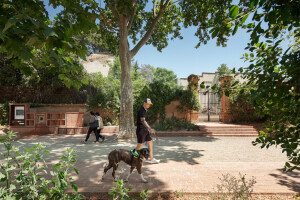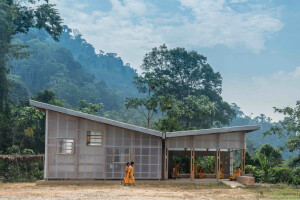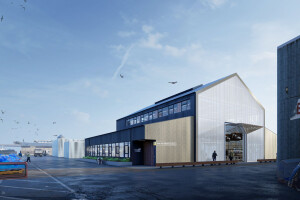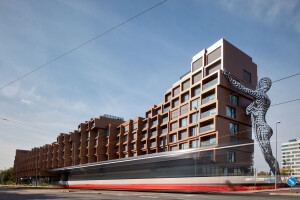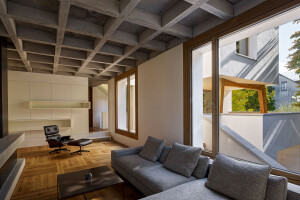The Fuchshofschule in Ludwigsburg's west is spatially designed to provide an appropriate place of learning and shared exchange for various large parts of the school community. The new school building, which emerged from a competition, now extends northwards from Fuchshofstraße. Based on the design image of a filled bookshelf on a playground, it was possible to transfer this ideal of school learning between the imparting of knowledge and social interaction into a wooden hybrid building. The three ceiling slabs cantilever out like shelves, offering the school community space for individual filling in the middle of a flowing outdoor area. For the new primary school in Ludwigsburg, a school building had to be developed that both complies with current standards with regard to its carbon emissions and offers the necessary rooms for contemporary learning concepts in all-day operation.


In addition to meeting places for the community, venues for performances and a refectory, communication-promoting rooms for the school staff, the actual learning clusters as well as the rooms for all-day care, music, handicraft and inclusion rooms were to be provided. Together with the school community, it was thus possible to develop a school in a timber hybrid construction that enables learning in different learning groups, communicative togetherness and individualization.


While the ground floor accommodates the rooms for the teaching staff, a communicative community zone around the central open staircase to the upper floors and the refectory, the learning clusters are found on the upper floors. All classrooms are connected to the perimeter arcade-like cantilevers by at least three French doors. They can be used for short breaks and allow a quick and uncomplicated walk into the fresh air. A wire mesh serves as fall protection and at the same time lets plenty of daylight into the classrooms.

Interior cores house all the necessary facilities, such as the sanitary facilities, and their boarded concrete surfaces reflect the building material wood. Each cluster can be subdivided again by a glass wall so that different learning situations can be tried out and reconfigured again and again. The rooms for all-day care are located on the first floor, while the music, work and inclusion rooms are located on the second floor. A roofed area cut into the building's cubature on the ground floor provides a buffer zone between inside and outside.

The rooms for the school staff are also located here, which promotes contact between students and teachers. The actual centre of the building is the large stair hall. It acts as a smooth transition between the entrance area and the playground and serves - generously lit from above - as an event and communal space. The central concrete staircase was partially covered with oak boards and thus not only functions as a mere distributor, but also makes it possible to sit comfortably and thus have an informal get-together as well as various learning situations.
The cafeteria has a clear connection to the yard. With its extensive glazing and the skylights in the centre of the room, this communal space is filled with daylight and connects the interior with the outdoor.

Two concrete cores rise up on the narrow sides, serving to brace the building. The timber construction of prefabricated elements develops around and between this solid structure: Cross-shaped wooden columns spatially structure the floor plan with their concise form, give it rhythm and act statically as supports in four directions for the building structure. The partition walls on the upper floor can be converted if necessary, as the load-bearing direction spans the classrooms from east to west. Due to the complete prefabrication of all timber components, the school building could be erected as quickly as it was low-emission and cost-effective - this was also and above all made possible by the precise work of all those involved in the construction, as the planning for the timber construction in prefabrication ultimately had to be very precisely coordinated with the tolerances of the in-situ concrete on the construction site.

The school building is part of a new neighbourhood and is thus very practically part of the necessary infrastructural facilities for the local population. The building offers space for contemporary learning in different constellations and thus meets today's educational demands.
The centrepiece of the Fuchshof School is the large staircase. It is the structural centre of the building and a place where the school community can come together for parties and performances as well as smaller groups of pupils for special forms of learning or informal chats.

The interior of the school building is characterised by natural materials and colour tones: linoleum floors with embedded, structure-giving cocoa shell pieces, natural acoustically effective wood-wool ceiling elements and glazed wooden components for columns, windows, doors and built-in elements complement the atmospheric calm basic tone with a rough-sawn exposed concrete structure. The colour concept is accentuated to match the entire interior, right down to the sanitary facilities, and deliberately focuses on a gender-neutral character. The colours serve not only as a design element, but also as a means of orientation and identity.

A special piece of furniture designed for the Fuchshof School was made for the learning clusters, which can be arranged as a table and bench combination to form various community-building shapes ranging from a circle to a serpentine line. This closes the circle of the design idea from the outdoor spaces to the communal spaces and the community-building centres of the learning clusters to the actual classrooms.

The use of wood as a building material made it possible to bind carbon, and the prefabrication of the wooden modules also made very fast construction possible. This made it possible to avoid exhaust emissions during delivery to the construction site as well as the protracted noise emissions caused by a time-consuming construction process.
















































